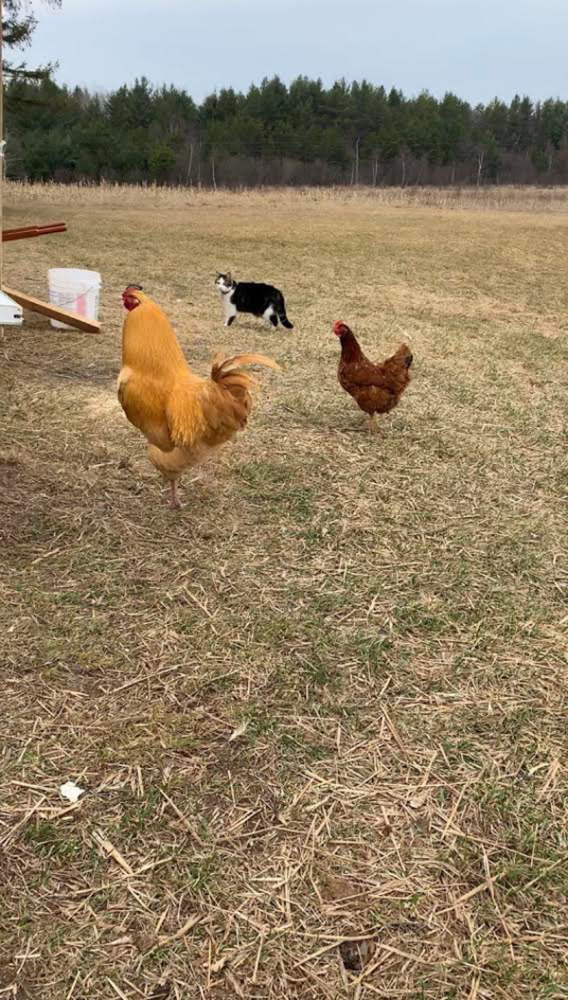What’s Killing The Chickens?
Skye Goode
As a trapper, I receive many requests to rid properties of nuisance animals. Among the chief complaints are attacks on chickens, a favorite target of predators looking for an easy meal. Everything from coyotes, feral cats, raptors, snakes and weasels will happily make a meal or meals of out of unsuspecting chickens. This article is designed to help identify which predator is targeting your chickens and what you can do to deter them from your chicken coop.
Oddly enough, the bigger the predator, the fewer the clues left after an attack. Smaller predators, like weasels, often leave hair on nails, wire fences and points of entry, particularly if there was a struggle. Some, like skunks, may leave a lingering odor. In the absence of hair and odor, it can generally be assumed that the perpetuator was larger predator, such as a fox, coyote, bobcat, or even a large owl. These are animals that can quickly and noiselessly grab an unsuspecting chicken and carry it off without leaving a trace.

Cunning cat contemplates a midnight chicken snack. Felines, like feral cats and bobcats, can be a major contributor to chicken mortality rates.
Feathers of the victim found near a fencepost or other perch would presume the work of a raptor, such as an owl or hawk. Conversely, missing chicks could have been stolen away by nearly any predator, including snakes, raccoons and rats.
Dead chickens left uneaten are the hallmarks of a domestic dog killing. Left to run loose, such dogs may play or kill for “sport.” Since they are usually well-fed, these dogs don’t bother eating what they slaughtered.
Dead chickens with blood around their heads and/or necks are the tell-tale signs of an attack by a mink or weasel. These are high-strung animals who prefer to kill at the throat and drink blood from the neck. Weasels also enjoy dining on chicken entrails. Mink will carry chicken carcasses to a specific area, as if “stockpiling” them. Why is a mystery to me. A mink may often leave a lingering musky odor behind at the scene of the attack.
If the wings or feet of the chicken have been left untouched, it was most likely killed by a feral cat or bobcat. Felines do not consume feathers or claws. Claw marks near buried remains are also indicative of chickens killed by felines. They will consume a portion of a chicken and bury the rest for later.
It’s not unusual for chickens killed by raccoons to be found decapitated near holes. In the event that the chicken is too big to get into a hole to be eaten, the raccoon may discard it after consuming its head and/or neck. The raccoon may just may eat the neck and leave the head resting against the bird’s body. Raccoons will also consume the grain found in a chicken’s stomach.
Chickens found alive with wounds about their heads and necks were probably victim to a raptor attack from above. Raptors will abandon prey too big to kill or carry away.
Chickens left alive with wounds on their feet and legs were probably attacked by a rat or opossum. They are not very accomplished predators and are often unsuccessful in their attempts to kill prey such as chickens.
Snakes, rats, skunks, raccoon, even bluejays and crows, will snatch and consume chicken eggs. Crows will usually carry the shells to a nearby perch/roost to eat. Snakes will consume the eggs whole right from the nest. Skunks and raccoon will leave the shells all over the area.
There are ways to protect chickens from predators, such as learning to trap. Guineas and roosters, however, can preclude the need for trapping; upon spotting a potential threat, the racket and ruckus they will raise can be enough to deter a predatory attack.
Regularly and thoroughly check your chicken coops for holes and cracks, no matter how tiny, and cover them. Rats and weasels can slip through openings only as big as an inch. Lock your chickens in their coops in the evening to protect them from nighttime prowlers.
Some preliminary work combined with traps will will go a long way to keep your chickens safe from predators.
Skye Goode lives in Central Wisconsin and works full-time as a career counselor as well as owns a small fur sewing business. She has two sons and has hunted, fished, and trapped all her life. She is a Wisconsin Trapper Education Instructor and a member of the National and Wisconsin Trappers Associations.











